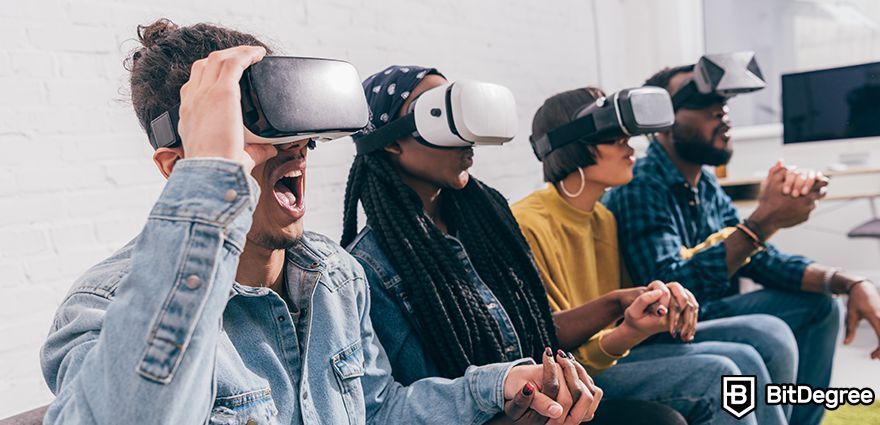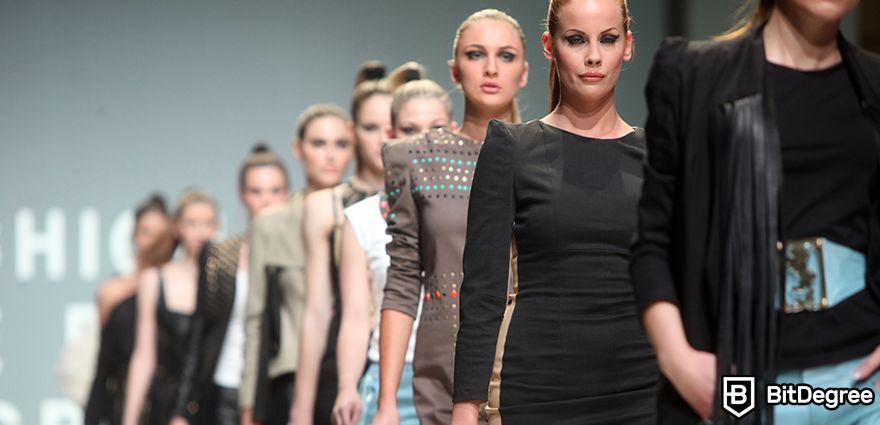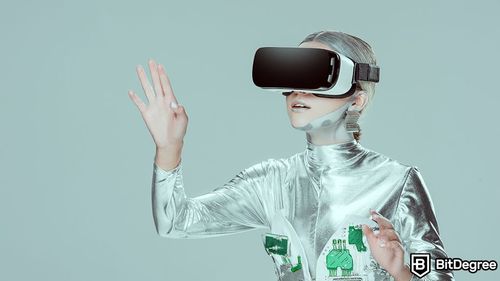Stop overpaying - start transferring money with Ogvio. Sign up, invite friends & grab Rewards now! 🎁
What is Digital Fashion?
As the blockchain industry grows and gets further integrated with the world, a range of fields and ideas have emerged, bringing increased attention, and subsequent confusion. One of the most fascinating examples of this is the currently evolving digital fashion sector. While this is a concept that has existed for some time, even before blockchain tech was prevalent, its connection with it has led to the space blossoming and morphing into something unique and extremely fruitful. But what exactly is digital fashion, and why has it become entangled with blockchain, cryptocurrency, and Web3?
Understanding Digital Fashion: Its Roots in Gaming
As the name suggests, at its core, digital fashion is simply the act of creating and displaying clothes in a digital setting. This means both building/designing clothes using computer programs, as well as having them worn on digital avatars. In the past, this was a highly niche field that was limited to the gaming industry, with designers crafting clothes that would be worn by characters within these programs.
However, with the emergence of blockchain-based metaverses, this field has grown into a full industry. In the past, digital clothes functioned as a way for game designers to simply adorn their characters in a certain way to build on a larger aesthetic that related to the game as a whole. If you think about the way characters in Legend of Zelda or Final Fantasy games are clothed, it is less about what exactly they wear, and more about how these clothes (or costumes) relate to the way the game-world itself feels.

Did you know?
Subscribe - We publish new crypto explainer videos every week!
Crypto Research Fundamentals: How to DYOR (Animated Explainer)


When it comes to multiplayer spaces, where users have more autonomy over what their characters (or avatars, as it would be more appropriate to call them) wear, it becomes more important for designers and developers to give their audiences options and control over how they act in these worlds. This idea could be considered the beginning of the current wave of digital fashion that we are experiencing.

In a single-player game, developers might build clothes that fit the style and environment of their characters. But in multiplayer, global, digital spaces that function less like games and more like virtual locations for people to meet, it is more about allowing people to adorn themselves with more freedom and self-expression.
Digital Fashion and the Metaverse
The metaverse and digital fashion go hand-in-hand. This is largely because, no matter where a person goes, whether that be to another physical place, or to a virtual one, they want to be viewed in a certain way, and they want their clothes to convey a certain message or idea about themselves. In blockchain-based metaverses, clothes play a huge factor in how people interact with the world, as they use digital fashion pieces to build outfits and wardrobes that are intended to represent themselves in a specific way.

The ideas that people have about fashion in the physical world extend to the virtual, as well. Just as clothes are used to control our image normally, the same is true for the metaverse. What we wear affects how people think of us, as well as how we think of ourselves. People want to be proud of how their avatar looks, and they want to show that off to others. This is one of the driving forces behind the digital fashion industry emerging in the metaverse.
This is partially why designer labels, such as Gucci, Coach, Burberry, and Valentino are expanding into this sector. They have recognized that the same factors that lead people to buy high-end clothes exist in the metaverse as well. People want to be seen with luxurious and aesthetically pleasing assets, regardless of where they are (in this world or in virtual ones). Status still exists in the metaverse, therefore, status symbols exist, too.
Digital Fashion and NFTs
When it comes to blockchain-based metaverses, NFTs play a huge role. This is especially true for digital fashion. NFTs allow users to have a collection of clothes that they can transport between different metaverse projects, provided they are interoperable, and the assets can be recognized by different networks.

Essentially, having NFT clothing means that people have the freedom to take their outfits to other spaces, without having to start over again from a blank slate. They give people more control over themselves, and let them easily present themselves in a similar way across a range of virtual locations.
NFTs also serve another deeply important purpose. The fact that each NFT is unique (due to their lack of fungibility), makes them perfect for creating digital pieces that have a distinct cryptographic identifier within them which people can use to assess whether somebody is wearing a piece that officially belongs to a certain brand, company, or project.
For instance, if you wear a shoe within the metaverse that was minted by Karl Lagerfeld, then when other people look at that shoe, they can see the metadata behind it and see that it is authentic, when it was minted, and how rare it is. This is even more impressive when it comes to one-of-one pieces, where a designer only created a single adornment.
This information would be contained within the NFT itself. At first glance, this might not seem particularly important, but for digital interactions, it is likely to become deeply sought-after. This is because clothing NFTs allow people to stand out and be represented as unique. In our physical world, being unique is often taken for granted, as we implicitly assume that everybody is distinct and individual when we meet them.
A major reason for this is because we all look different to some extent (even twins). We have a range of both subtle and striking features that make up who we are aesthetically, as no two humans are built exactly the same. But in the metaverse, avatars have a level of uniformity to them. There are some changes that might be able to be made to an avatar to make them stand out, but in terms of appearance, our uniqueness is not a given. It is something that is crafted at our own hands, and by our own choices.
Clothing plays a huge role in this on the virtual plane. To give the best chances of being perceived as unique, it makes sense to wear NFT clothes as these can directly convey to others that they are rare or even one-of-one, meaning that only one person owns them. Building whole outfits can help with this, too, where a collection of clothes that one person wears can be used as a way to identify them online as they are the only person with them.
It might sound somewhat irrelevant, but the desire to be perceived as unique is a documented human desire, referred to in psychology as the Need for Uniqueness (NfU). It is the innate human compulsion to be viewed as both unique to others as well as to themselves. It is one of the driving concepts behind our consumerist world, and it is bound to affect our virtual worlds, too.
With this in mind, NFTs become the perfect vessel for achieving this unique perception, as clothes and outfits can be attributed to people in a way that conveys that only they have those pieces. If this need cannot be satisfied by blockchain-based metaverses, then people may start to feel disillusioned and uncomfortable.
Along with this, NFTs can be used to help certain groups of people identify each other. In the physical world, clothes are used as a way of signaling to other people that you are part of a distinct socio-economic class and culture. The same is likely to be true in the metaverse. For instance, if somebody is part of a certain society, then they might wear a particular type of NFT as a way of showing others that this is who they are and what they associate with.
If it is an exclusive group, like being part of a governance community for a certain blockchain, or a member of a team, then the clothes might only be attainable in specific ways, or distributed to a select number of people. NFTs are the best tool for this, as they have an inherent exclusivity and rarity aspect associated with them.
Pushing the Industry to Its Limits
Currently, the way digital fashion has been discussed is as a not-so-carbon copy of how fashion works in the physical world. However, there are some fantastic things this industry can do that differentiate it. For starters, when it comes to physical fashion, designers are limited by the types of materials they can use, and by how those materials drape on the human body, in relation to how real-world physics works.

In a metaverse, blockchain-based or otherwise, these constraints do not exist. This allows for mesmerizing and majestic creations to exist that do not conform to the normal standards of clothing. For instance, outfits can float in virtual air, move in unique ways, glow, change color, or morph into different patterns. They can be grandiose in a way that is not typically possible.
Think of it as similar to how car companies create concept cars that look otherworldly due to avoiding the need to be road-safe or conform to legal regulations. However, with digital clothing, not only are there even fewer constraints than this (due to a lack of physics), but they are also attainable and usable by people.
High-end brands have not explored this concept as extensively as they could, but there are some digital-native designers who are pushing the limits of clothing with this idea in mind. The Fabricant, Auroboros, and Tribute, are three houses that make use of this lack of restriction to build digital pieces that are striking, outlandish, and impossible to produce in physicality. They show how truly diverse and imaginative digital fashion can be.
Digital Fashion and Mixed Reality
With the emergence of the metaverse has come alongside it a desire to bring some virtual elements to the physical world. This is known as mixed reality, and it is where virtual and real-world objects coexist and interact in real time. Mixed reality bridges the gap between pure virtual reality, which fully immerses users in a digital environment, and augmented reality, which merely overlays virtual objects in the real world. This hybrid approach enables a more seamless integration of digital elements into our everyday surroundings, creating experiences that are more engaging and immersive.

In the context of digital fashion, it allows people to have certain virtual clothes represented in photographs of themselves, or attached to them when people see them through augmented reality headsets. These pieces are often still NFT-based, meaning they can be brought into the metaverse, but with this in mind, they can now be seen in physical spaces, provided people are wearing the right goggles or glasses.
To facilitate this, some companies are using Snapchat and Tiktok lenses to achieve this. In an age where people are so focused on being viewed through a screen, the ability to have digital fashion adorned on you whenever somebody takes a photo or video is a great way of showing and broadcasting status.
Conclusions
The digital fashion sector is one of the most exciting emerging spaces in the blockchain industry (as well as in the art world). With household names vying for attention in the market, along with digital native and smaller designers pushing boundaries, there is a wide range of choices for consumers.
We are in a fascinating period right now where designers and developers are still in the process of shaping the sector, simultaneously while buyers are exploring it. This is, by all means, a space that is in its infancy. What we think of digital fashion now may be very different from what we think of it in the next five or ten years. Not only might aesthetic desires shift, but technological advancements may also have an impact on how this type of art is created, worn, and appreciated.




.jpg?tr=w-400)







![How to Transfer Money Without Fees? [Animated Tips 2025] How to Transfer Money Without Fees? [Animated Tips 2025]](https://assets.bitdegree.org/youtube/crypto-finally-explained/how-to-transfer-money-without-fees-animated-tips-2025.jpg?tr=w-400)









